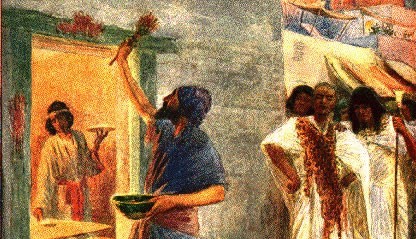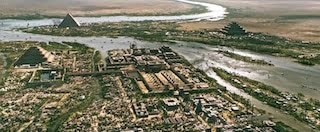I. THE DELUGE. With regard to this event we note:
1. The fact of a general deluge is stated in Scripture (Gen. 7.), and attested by the traditions of nearly all nations. Compare the story of Xisuthros in Berosus; the record in the Chaldean tablets; the Greek myth of Deucalion; the Mexican tradition; and the legends of the North American Indians.[A]
2. The date is given in reference Bibles (following Archbishop Ussher) as B. C. 2348. This is probably incorrect. It may have been a thousand years earlier. But as archæologists are not yet agreed, we give Ussher's chronology, here and elsewhere, merely as a convenience in the arrangement, not as accurate.
3. Its cause was the wickedness of the human race (Gen. 6. 5-7). Before this event all the population of the world was massed together, forming one vast family and speaking one language. Under these conditions the good were overborne by evil surroundings, and general corruption followed.
4. Its extent was undoubtedly not the entire globe, but so much of it as was occupied by the human race (Gen. 7. 23), probably the Euphrates valley. Many Christian scholars, however, hold to the view that the Book of Genesis relates the history of but one family of races, and not all the race; consequently, that the flood may have been partial, as far as mankind is concerned.
II. THE DISPERSION OF THE RACES. (B.C. 2247?) 1.
Very soon after the deluge a new instinct, that of migration, took possession of the human family. Hitherto all mankind had lived together; from this time they began to scatter. As a result came tribes, nations, languages, and varieties of civilization. "The confusion of tongues" was not the cause, but the result of this spirit, and was not sudden, but gradual (Gen. 11. 2, 7)
III. THE RISE OF THE EMPIRES.
In the Bible world three centers of national life arose, not far apart in time, each of which became a powerful kingdom, and in turn ruled all the Oriental lands. The strifes of these three nations, their rise and fall, constitute the matter of ancient Oriental history, which is closely connected with that of the Bible. These three centers were Egypt (called in the Bible Mizraim, Gen. 10. 6, 13), of which the capital was Memphis; Chaldea, of which the capital was Babel or Babylon (Gen. 10. 10; 11. 2-9); and Assyria, of which the capital was Nineveh (Gen. 10. 11). We might add to these the Canaanite or Phenician city of Sidon (Gen. 10. 15, 19), and its daughter Tyre, the great commercial centers of the ancient world, whose empire was not the land, but the sea. Note that all of these early kingdoms were established by the Hamitic race.
IV. THE MIGRATION OF ABRAHAM. (B. C. 1921?)
No other journey in history has the importance of that transfer of the little clan of Abraham from the plain of Shinar to the mountains of Palestine in view of its results to the world. Compare with it the voyage of the Mayflower. Its causes were: 1. Probably the migratory instinct of the age, for it was the epoch of tribal movements. 2. The political cause may have been the desire for liberty from the rule of the Accadian dynasty that had become dominant in Chaldea. 3. But the deepest motive was religious, a purpose to escape from the idolatrous influences of Chaldea, and to find a home for the worship of God in what was then "the new West," where population was thin. It was by the call of God that Abraham set forth on his journey (Gen. 12. 1-3).
V. THE JOURNEYS OF THE PATRIARCHS. (B. C. 1921-1706?) For two centuries the little clan of Abraham's family lived in Palestine as strangers, pitching their tents in various localities, wherever pasturage was abundant,[21] for at this time they were shepherds and herdsmen (Gen. 13. 2; 46. 34). Their home was generally in the southern part of the country, west of the Dead Sea, and their relations with the Amorites, Canaanites, and Philistines on the soil were generally friendly (Gen. 20. 14; 26. 26-31).
VI. THE SOJOURN IN EGYPT. (B. C. 1706-1491?) After three generations the branch of Abraham's family belonging to his grandson Jacob or Israel removed to Egypt (Deut. 26. 5), where they remained either two hundred or four hundred years, according to different opinions.[B] This stay in Egypt is always called "the sojourn." The event which led directly to the descent into Egypt was the selling of Joseph (Gen. 37. 28). But we can trace a providential purpose in the transfer. Its objects were:
1. Preservation. The frequent famines in Palestine (Gen. 12. 10; 26. 1;42. 1-3) showed that as shepherds the Israelites could not be supported in the land. On the fertile soil of Egypt, with three crops each year, they would find food in abundance.
2. Growth. At the end of the stay in Canaan the Israelites counted only seventy souls (Gen. 46. 27); but at the close of the sojourn in Egypt they had increased to nearly two millions (Exod. 12. 37; Num. 1. 45, 46). The hot climate and cheap food of Egypt has always caused an abundant population. In Egypt Israel grew from a family to a nation.
3. Isolation. There was great danger to the morals and religion of the Israelites in the land of Canaan. Abraham had sent to his own relatives at Haran for a wife for Isaac[23] (Gen. 24. 3, 4) in order to keep both the race and the faith pure. One of Isaac's sons married Canaanite wives, and as a result his descendants, the Edomites, lost the faith and became idolaters (Gen. 26. 34, 35). Jacob sought his wives among his own relatives (Gen. 28. 1, 2). We note a dangerous tendency in Jacob's family to ally themselves with the Canaanites (Gen. 34. 8-10; 38. 1, 2). If they had stayed in Canaan the chosen family would have become lost among the heathen. But in Egypt they lived apart, and were kept by the caste system from union with the people (Gen. 46. 34; 43. 32). It was a necessary element in the divine plan that Israel should dwell apart from other nations (Num. 23. 9).
4. Civilization. The Egyptians were far in advance of all other nations of that age in intelligence, in the organization of society, and in government. Though the Israelites lived apart from them, they were among them, and learned much of their knowledge. Whatever may have been their condition at the beginning of the sojourn, at the end of it they had a written language (Exod. 24. 7), a system of worship (Exod. 19. 22; 33. 7), and a leader who had received the highest culture of his age (Acts 7. 22). As one result of the sojourn the Israelites were transformed from shepherds and herdsmen to tillers of the soil—a higher manner of living
\\\\\\\\\\\\\\\\\\\\\\\\\\\\\\\\\\\\\\\\\\\\\\\\\\\\\\\\\\\\\\\\\\\\\\\\\\\\\\\\\\\\\\\\\\\\\\\\\\\\\\\\\\\\\\\\\\\\\\\\\\\\\\\\\\\\\\\\\\\\\\\\\\\\
THE WANDERING IN THE WILDERNESS.
1. The Oppression of the Israelites. (B. C. 1635.) (Exod. 1. 8-13.) This was an important link in the chain of events. If the Israelites had been prosperous and happy in Egypt they would have remained there, and the destiny of the chosen people would have been forgotten. Therefore, when Egypt had given to Israel all that it could, the wrath of man was made to praise God; and by suffering the Israelites were made willing to leave the land of their sojourn and seek the land of promise. The nest was stirred up, and the young eaglet was compelled to fly (Deut. 32. 11, 12).

2. The Training of Moses. (Born B. C. 1571.) There was another element of preparation. No common man could have wrought the great work of liberation, of legislation, and of training which Israel needed. Notice, 1.) Moses was an Israelite in birth, of the consecrated tribe of Levi (Exod. 2. 1, 2). 2.) But he was educated in the palace, and in the highest culture, as a prince in Egypt (Exod. 2. 10). If he had been doomed to a slave's life he could never have accomplished his mission. 3.) At full age Moses made choice of his people, because they were the people of God (Heb. 11. 24-26). 4.) Then came the training of forty years in the desert, giving him knowledge of the land, experience of hardships, and maturity of thought. 5.) Lastly, there was the call of God (Exod. 3. 2), with its revelation of God's name and power, imparting strength for his work.


3. The Ten Plagues. There was a special significance in these plagues, for each was a blow at some form of idol-worship among the Egyptians. They were: 1.) The river turned to blood (Exod. 7. 20, 21). 2.) Frogs (Exod. 8. 6).[26] 3.) Lice (Exod. 8. 17). 4.) Flies, probably including beetles and other winged pests (Exod. 8. 24). 5.) Murrain, or pestilence among domestic animals (Exod. 9. 3, 4). 6.) Boils (Exod. 9. 10). 7.) Hail (Exod. 9. 23). 8.) Locusts (Exod. 10. 14, 15). 9.) Darkness (Exod. 10. 22, 23). 10.) Death of the first-born (Exod. 12. 29).



4. The Passover. (Exod. 12. 21-28.) This service represented three ideas. 1.) It was the spring-tide festival. 2.) It commemorated the sudden departure from Egypt, when there was not even time to "raise the bread" before leaving (Exod. 12. 34-39). 3.) It was an impressive prophecy of Christ, the slain Lamb of God (Exod. 12. 21, 22).
5. The Exodus. (B. C. 1491.)
(Exod. 12. 40, 41.) The word means "going out." This was the birthday of a nation, the hour when the Israelites rose from being merely a mass of men to become a people.
II. THE WILDERNESS OF THE WANDERING.

1.The "great sea," or Mediterranean (Josh. 1. 4).

DESERT OF SHUR
2.) The Red Sea (Exod. 13. 18), The Dead Sea.
2. five Deserts. 1.) The Desert of Shur (Exod. 15. 22), between Goshen and Canaan. 2.) The Desert of Paran, in the center of the Sinaitic triangle (Num. 10. 12). This is the wilderness in which thirty-eight of the forty years were passed (Deut. 1. 19). 3.) The Desert of E'ham (Num. 33. 8), on the shore of the Gulf of Suez. 4.) The Desert of Sin, near Mount Sinai (Exod. 16. 1). 5.) The Desert of Zin, the desolate valley between the Gulf of Akaba and the Dead Sea, now called the Arabah (Num. 13. 21).
goshen
Mt Sinai
Rameses, the starting-point of the Israelitesexodus
Baal-zephon, the place of crossing the Red Sea
land of moab
GOSHEN
3. five Lands of this region. 1.) GoshEN, the land of the sojourn (Exod. 9. 26). 2.) Midian, the land of Moses's shepherd life (Exod. 2. 15), on both sides of the Gulf of Akaba. 3.) Edom, the land of Esau's descendants, south of the Dead Sea (Num. 21. 4). 4.) Moab, the land of Lot's descendants, east of the Dead Sea (Num. 21. 13). 5.) Canaan, the land of promise (Gen. 12. 7).
4. Fix also the location of three Mountains. 1.) Mount Sinai, where the law was given (Exod. 19. 20). 2.) Mount Hor, where Aaron died (Num. 20. 23-28). 3.)Mount Nebo (Pisgah), where Moses died (Deut. 34. 1).
5seven Places, some of which are clearly, others not so definitely, identified. 1.) Rameses, the starting-point of the Israelites (Exod. 12. 37). 2.) Baal-zephon, the place of crossing the Red Sea (Exod. 14. 2). 3.) Marah, where the bitter waters were sweetened (Exod. 15. 22-25). 4.) Elim, the place of rest (Exod. 15. 27). 5.) Rephidim, the place of the first battle, near Mount Sinai (Exod. 17. 8-16). 6.) Kadesh-barnea,[C] whence the spies were sent forth (Num. 13. 26).[28] 7.) Jahaz, in the land of Moab, south of the brook Arnon, the place of a victory over the Amorites (Num. 21. 23, 24).
 AMORITES
AMORITES
============================================
http://www.gutenberg.org/files/36444/36444-h/36444-h.htm
1 http://www.gutenberg.org/files/36444/36444-h/36444-h.htm#Page_17
============================================



No comments:
Post a Comment